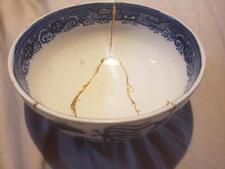 A while after Tim died, a dear friend bought me a Kintsugi kit, complete with a broken bowl. Kintsugi, which translates as 'golden repair', is the Japanese art of repairing broken pottery with a glue dusted with or mixed with powdered gold. Japanese aesthetics has a perspective called wabi-sabi, which appreciates beauty that is "imperfect, impermanent, and incomplete". Those of us who grieve often try to hide our sadness, our brokenness, our emotional and mental scars. Kintsugi as a grief model suggests that we show our scars and treat them as part of us and part of our stories. Living with or alongside our grief, moving forward but not moving on, it's what makes us who we are. Kintsugi "symbolises the truth that repair requires transformation, that the pristine is less beautiful than the broken—and that the shape of us is impossible to see until its fractured, until a wound, like a crack, runs its length." I described it in a blog as "a brave with the stitches showing and the glue not quite set. It's a broken and mended brave… a brave that sees the beauty in the flaws. And while it's a kind of brave that doesn't always withstand a puff of wind, I'm hoping it might be the kind that will stand up to a storm." It took me three and a half years to make the bowl, and I made it to celebrate some major steps in my life after Tim. And I love it.
0 Comments
Leave a Reply. |
AuthorI was widowed at 50 when Tim, who I expected would be my happy-ever-after following a marriage break-up, died suddenly from heart failure linked to his type 2 diabetes. Though we'd known each other since our early 20s, we'd been married less than ten years. Archives
July 2024
Categories
All
|


 RSS Feed
RSS Feed